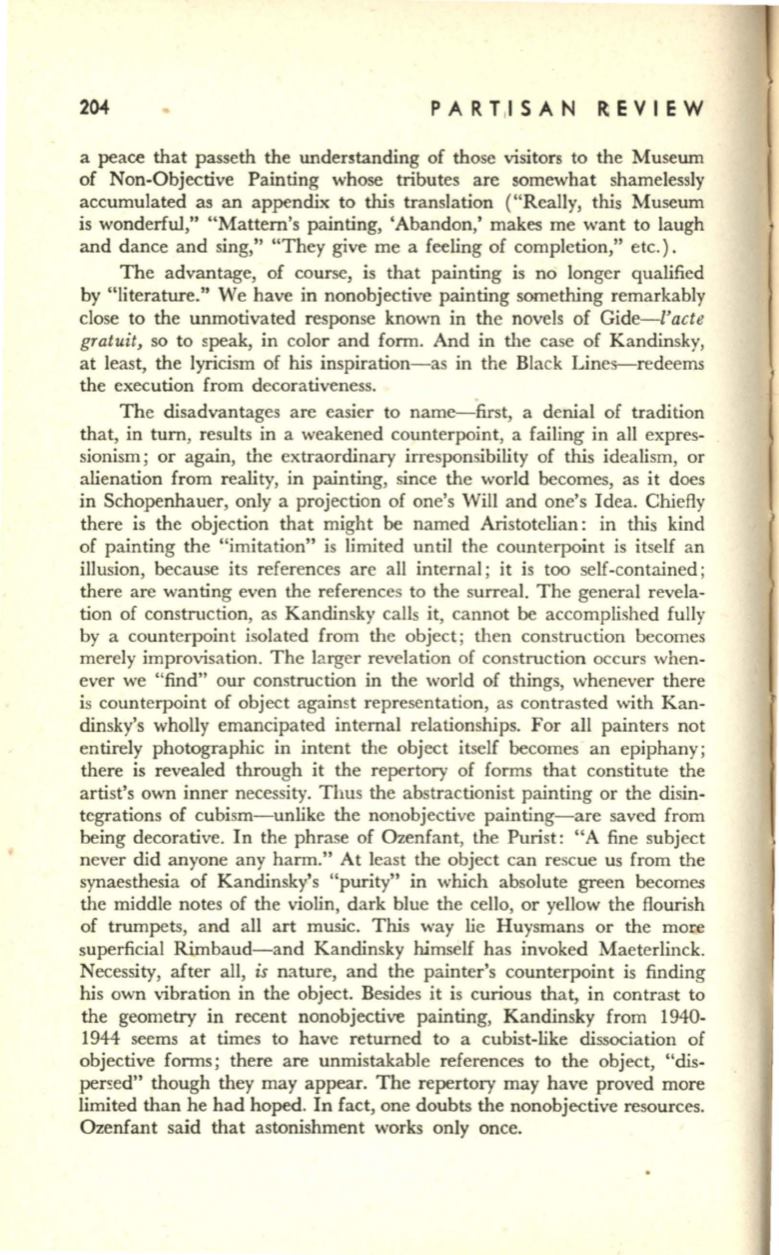
204
PA RT,I SA N R E
V I
EW
a peace that passeth the understanding of those visitors to the Museum
of Non-Objective Painting whose tributes are somewhat shamelessly
accumulated as an appendix to this translation ("Really, this Museum
is wonderful," "Mattern's painting, 'Abandon,' makes me want to laugh
and dance and sing," "They give me a feeling of completion,'' etc.) .
The advantage, of course, is that painting is no longer qualified
by "literature." We have in nonobjective painting something remarkably
close to the unmotivated response known in the novels of Gide-l'
acte
gratuit,
so to speak, in color and form. And in the case of Kandinsky,
at least, the lyricism of his inspiration-as in the Black Lines-redeems
the execution from decorativeness.
The disadvantages are easier to name-first, a denial of tradition
that, in tum, results in a weakened counterpoint, a failing in all expres–
sionism; or again, the extraordinary irresponsibility of this idealism, or
alienation from reality, in painting, since the world becomes, as it does
in Schopenhauer, only a projection of one's Will and one's Idea. Chiefly
there is the objection that might be named Aristotelian: in this kind
of painting the "imitation" is limited until the counterpoint is itself an
illusion, because its references are all internal; it is too self-contained ;
there are wanting even the references to the surreal. The general revela–
tion of construction, as Kandinsky calls it, cannot be accomplished fully
by a counterpoint isolated from the object; then construction becomes
merely improvisation. The larger revelation of construction occurs when–
ever we "find" our construction in the world of things, whenever there
is counterpoint of object against representation, as contrasted with Kan–
dinsky's wholly emancipated internal relationships. For all painters not
entirely photographic in intent the object itself becomes an epiphany;
there is revealed through it the repertory of forms that constitute the
artist's own inner necessity. Thus the abstractionist painting or the disin–
tegrations of cubism-unlike the nonobjective painting-are saved from
being decorative. In the phrase of Ozenfant, the Purist: "A fine subject
never did anyone any harm." At least the object can rescue us from the
synaesthesia of Kandinsky's "purity" in which absolute green becomes
the middle notes of the violin, dark blue the cello, or yellow the flourish
of trumpets, and all art music. This way lie Huysmans or the more
superficial Rimbaud-and Kandinsky himself has invoked Maeterlinck.
Necessity, after all,
is
nature, and the painter's counterpoint is finding
his own vibration in the object. Besides it is curious that, in contrast to
the geometry in recent nonobjective painting, Kandinsky from 1940-
1944 seems at times to have returned to a cubist-like dissociation of
objective forms; there are unmistakable references to the object, "dis–
per~ed"
though they may appear. The repertory may have proved more
limited than he had hoped. In fact, one doubts the nonobjective resources.
Ozenfant said that astonishment works only once.


